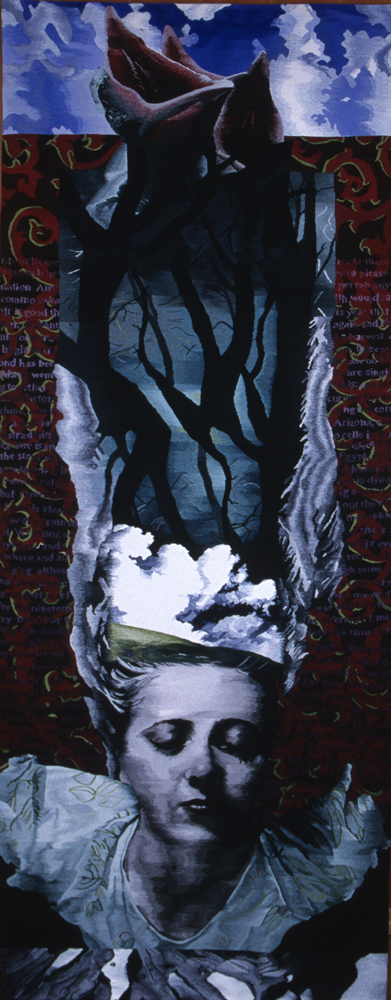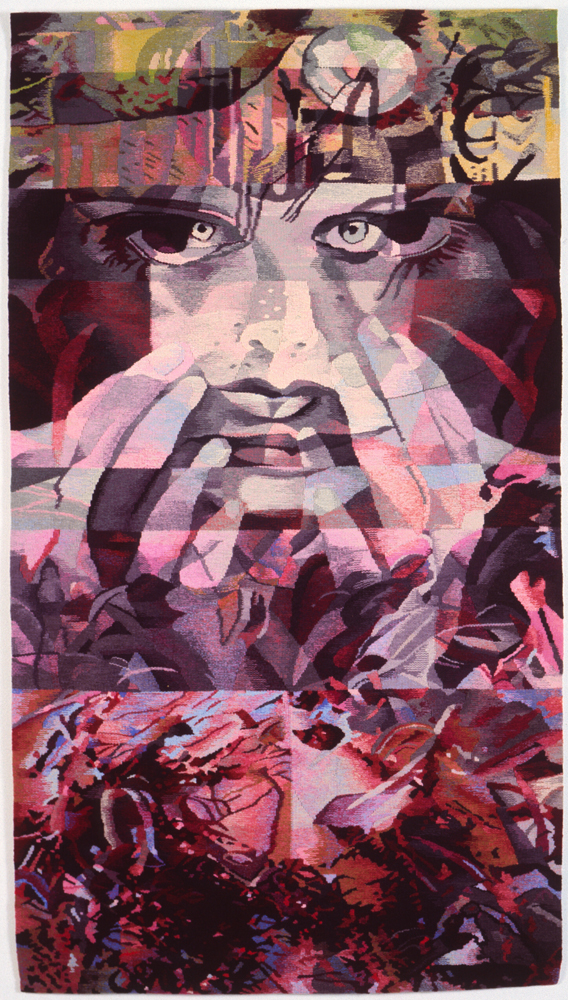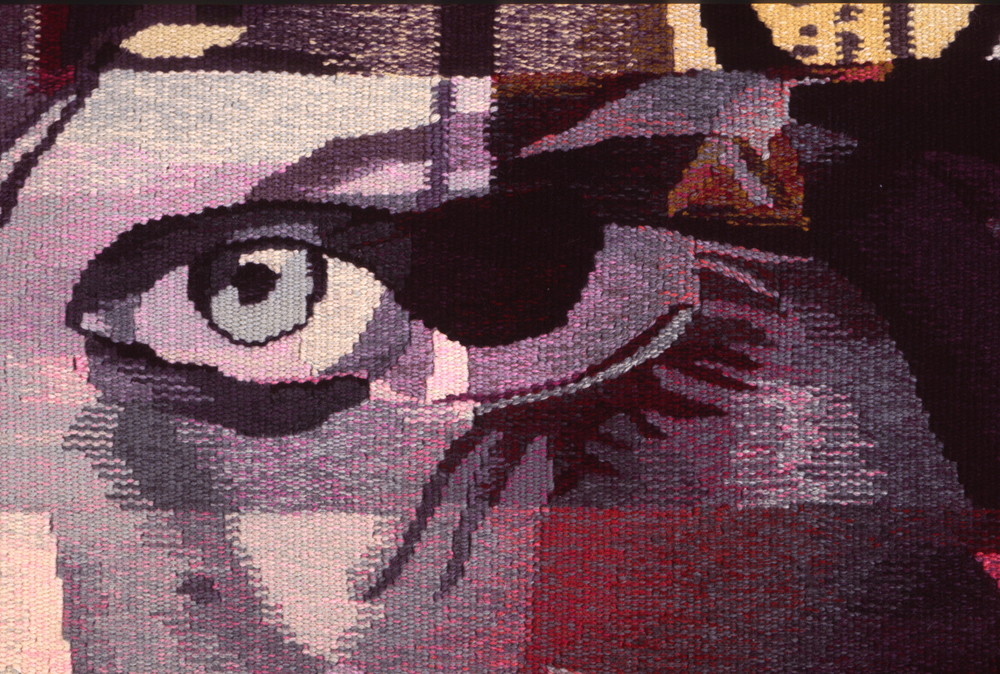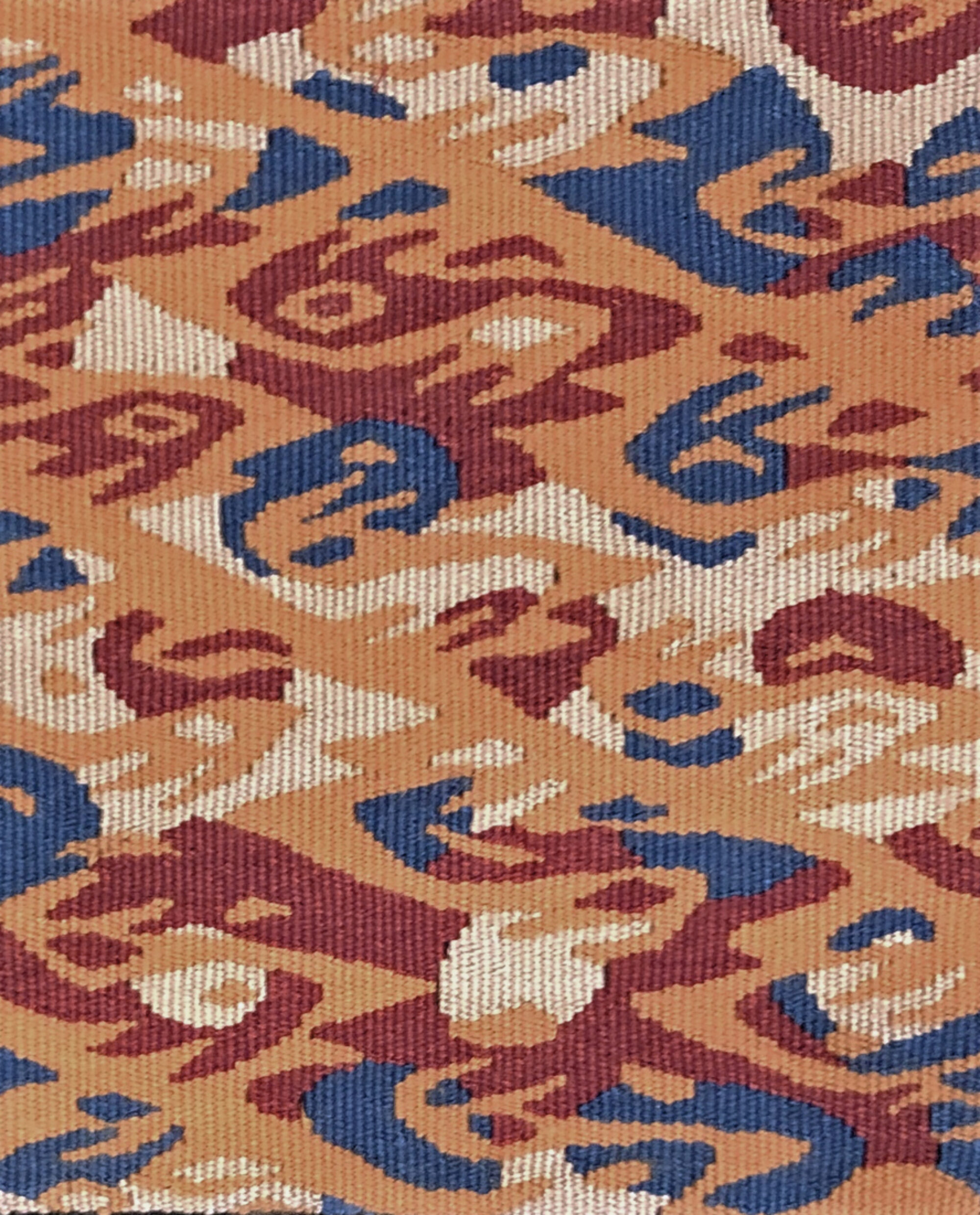This article was first published in the Summer 2005 issue of Fiberarts Magazine.
Shelley Socolofsky’s recent tapestries are visually arresting testaments to the power of pictorial tapestry. Their ambitious scale and finely woven detail speak to the dedication of the artist and their complex and evocative imagery reveals the probing of an inquisitive mind.

Soliloquy was commissioned by Western Oregon University for the Wayne and Lynn Hammersly Library, where it hangs in a stairwell. The maquette for the tapestry is a collage, a technique with which Socolofsky has experimented for a number of years. Pablo Picasso and Georges Braque are credited with pioneering the use of collage in fine art. Their formal explorations into alternative ways of representing the world included applying actual objects to their canvases. Collage assumed a more psychologically charged role in the work of the Surrealists, where the non-intuitive juxtaposition of objects created fantastic dreamscapes. During the 1950s artists such as Robert Rauschenberg employed collage as a challenge to Greenbergian aesthetics, which advocated the kind of devotion to materials that precluded representation. Rauschenberg’s Combines did not represent objects; they were the objects. Late 20th and early 21st century artists continue to find collage to be a fertile and relevant technique. An examination of Socolofsky’s tapestries will reveal why this is so.
The maquette for Soliloquy collages photographs, repeat patterning and text into a rich and evocative reference to growth and knowledge. The woman at the bottom of the tapestry wears a dress patterned with leaves. Within a state of deep contemplation her mind opens to an infinite sky and the kinds of possibilities one might dream of on a sunny day. The woman’s hair streams upward merging with tree branches, symbols of growth and aspiration. The baby birds suggest the potential of youth and their gaping mouths evoke the hunger for knowledge that leads to invention. Their raw potential is grounded by the contemplative figure who turns her attention inward. Surrounding the central imagery a pattern of arabesques reinforces the theme of growth. The text of poetry covering the arabesques is legible, but elusive.
The vertical development of the imagery in Soliloquy parallels patterns of growth and echoes the ascending staircase in which the tapestry hangs. The combination of images, words and decorative patterning deepens the layers of meaning and association and invites a more sustained reflection. In Socolofsky’s image an introspective female symbolizes hope and growth. This muse’s soliloquy envisions a future built not only on knowledge but also on dreams. For the development of the individual, and of culture, depends not only on the objectivity of factual information but also on the subjectivity associated with emotions and the spirit, and with poetry.
In developing her collages Socolofsky works intuitively, approaching the process of assembling and manipulating images as a “journey of discovery.”1 Her source materials include drawings, paintings, photographs, found images and text. She does not strive for seamless transitions between the images. Instead, she highlights the process of collage by emphasizing the edges. Each bit of paper evidences the artist’s choices and actions. The reconciliation of these fragmentary bits and pieces occurs through the weaving process. The irony of translating a process built upon discontinuity into whole cloth is itself intriguing.
One of the widely admired attributes of historical tapestry is the incredible narrative detail. Many of those images were also composed from varied source material. Socolofsky continues this tradition in her work, although from the more postmodern perspective of commentary and personal reflection.

In 2001Socolofsky began to explore digital collage, producing works such as Incantations. Working with collage on the computer allows more transparency in the layering of images. According to the artist,” This type of illusional layering symbolizes… peeking underneath the surface of things… chipping away at the superficiality of surface to the heart and soul of the matter.”2 The contrast between the spontaneous and high-tech nature of her designs and the low-tech nature of the tapestry weaving process is not lost on Socolofsky. Her commitment to the medium, like many practitioners, reflects both reverence for the medium and defiance against the pace of contemporary life.
In Incantations the artist has created a dense and multilayered composition. The superimposed hands and faces of two women emerge from and disappear into a composite of imagery whose origins are difficult to ascertain. The larger than life size, composite visage, stares intensely, demanding our attention. The highly active field surrounding the figure, the limited color range and the strong value contrast all add to the power of the image. The complexity and dreamlike quality of the penetrating, even haunting, vision in Incantations pulls us into a magical space that suggests ritual and psychological transformation.

Incantations is not a simple, uncomplicated image. And that is, most likely, the artist’s intention. Socolofsky’s deliberately intricate and elusive imagery rejects the notion of a unified picture plane. It suggests, instead, that our understanding of the world is based on a mélange of experiences that are not always without contradiction. We become skilled at sorting through the noise to create order and meaning, to simplify what could otherwise be overwhelming. Socolofsky’s work implies that the messiness of the sensory input bombarding us every day has its own value. It also suggests that approaching complexity, ambiguity and contradiction from a more subjective viewpoint might offer a richer perspective, a perspective that acknowledges multiple layers of signification and reveals new connections.
The strength of Socolofsky’s tapestries arises from the artist’s combination of collage, which elaborates the meaning of the work, and tapestry, which emphasizes its gravity. Their significance lies in the interplay of technique and content and its successful realization within the artwork.
End Notes
1 Socolofsky, Shelley Letter to the author, 2005.
2 Socolofsky, Shelley Letter to the author, 2005.
